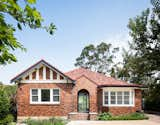10 Mullet Homes That Are Traditional in the Front, Modern in the Back
In a "mullet home," the facade adheres to the neighborhood vernacular, while the interior and rear facades are bolder and more modern.
Here are 10 mullet homes where the contemporary hides behind conservative fronts.
1) A Renovated 19th-Century Cedar-Shingled Home
D.C. architect Robert Gurney renovated this 19th-century home in the coastal city of Lewes in Delaware, and restored the facade with cedar shingles.
2) An Updated Foursquare With a Fifth Addition
Built in 1910, this American Foursquare-style home in Portland, Oregon was transformed into a light filled home by LEVER Architecture with an addition of a "fifth square" in the form of a modern glass box.
3) A Refreshed Prefab Brewer’s Cottage
Architects David Nicholson and Brett Robertson of Robert Nichol & Sons had to abide by strict heritage regulations when they renovated this 1850s prefab timber cottage in Melbourne.
"Hemmed in by taller buildings on both sides, the original cottage was overwhelmed and neglected for decades—its identity compromised by inappropriate treatments. The new design provides a sensitive and recessive backdrop to the faithfully restored dwelling that originated more than 160 years ago in England," says Nicholson.
4) An Arts and Crafts-Style House with a Modernized Rear
When New South Wales practice TRIBE Studio Architects renovated this 1930s Arts and Crafts-style bungalow in Sydney, Australia, they kept the gabled brick wall and terracotta roof, suburban vernacular in the front, but revamped the rear with a fully glazed wall to better connect it to the garden.
Instead of focusing on reworking the street-facing front wall of the house, they turned their attention to the back wall, and found a better way to connect the interiors with the beautiful garden. This allowed them to stay true to the suburban vernacular of gabled brick walls and a terra-cotta roof, while modernizing the back section of the house quite dramatically.
The architects cleared out the ground floor and created an open-plan living, dining, and kitchen area along an elongated section at the rear. Floor-to-ceiling glass sliding doors were installed in this part of the house to connect the interiors with the spacious garden. This light-filled and highly-transparent half of the ground floor now serves as a shady extension of the lush green garden.
5) A Home in Estoril With Fully Transformed Interiors
Portuguese architect Ricardo Moreno overhauled the interiors of this old, 1923 house in Estoril, which serves as his family home, but preserved its historic facade.
6) A New Rear Extension For an Edwardian Cottage
Designed by Sheri Haby Architects, this Edwardian timber home in the Melbourne suburb of Sandringham has a new extension with two new gabled roofs that better connect the updated rear section with the garden.
7) A Bright and Breezy Brick House
Mexico City–based Dosa Studio redesigned this 40-year-old residence on a main road in Texcoco, Mexico, with two interior courtyards that increase space, light, ventilation and privacy.
8) A Victorian Cottage With a Neon Pink Corridor
This semi-detached Victorian cottage in Melbourne by architect Michael Artemenko, co-director of FIGR Architecture Studio, has a portal-like corridor that connects the original period home to a new wing.
9) A Double-Height Spanish Apartment With Floating Stairs
Spanish architecture firm RÄS Studio (now CRÜ) connected two formerly separate levels within a building in the historic neighborhood of Vila de Gràcia in Barcelona, turning the combined spaces into a stunning contemporary apartment with a floating staircase.
10) A Propeller Factory Conversion
New York City architecture and interior design firm Fogarty Finger converted this former propeller factory in Jersey City into a stylish, modern home that references its industrial past.
Published
Last Updated
Topics
RoundupsGet the Dwell Newsletter
Be the first to see our latest home tours, design news, and more.



















